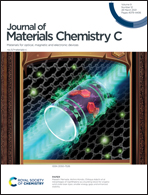Combined effects of ion-pairing on multi-emissive properties of benzimidazolium salts†
Abstract
The possibility to control luminescence properties of purely organic emitting salts is receiving an ever-growing interest. A full understanding of the manifold effects of counterions on the photophysical properties of charged luminophors deserves thorough investigation. Here, we disclose the impact of different anions, i.e. triflate, iodide and nitrate, on the multiple emissions of a new class of ionic luminophors, based on 1,3-dimethyl-2-(p-tolyl)-1H-benzo[d]imidazol-3-ium, 1. The specific ion-pairing plays a key role in the emissive properties of solids, depending on both the electronegativity of the anion and its distance from the cation. Three main effects emerge from strong ion-pairing: (i) fluorescence quenching, (ii) phosphorescence enhancement and iii) efficient direct population of the triplet-state. As a result, a weak interaction (1-OTf) guarantees intense fluorescence (QY > 50%), while a strong pairing (1-NO3·0.5EtOH and 1-I·0.5CH2Cl2) promotes molecular room temperature phosphorescence (RTP) enhancement. The anion-controlling strategy also enables long-lasting RTP (288 ms) in 1-OTf and ultrabright phosphorescence (QY > 70%) in 1-NO3·0.5EtOH, under direct triplet-excitation at 350 nm.



 Please wait while we load your content...
Please wait while we load your content...